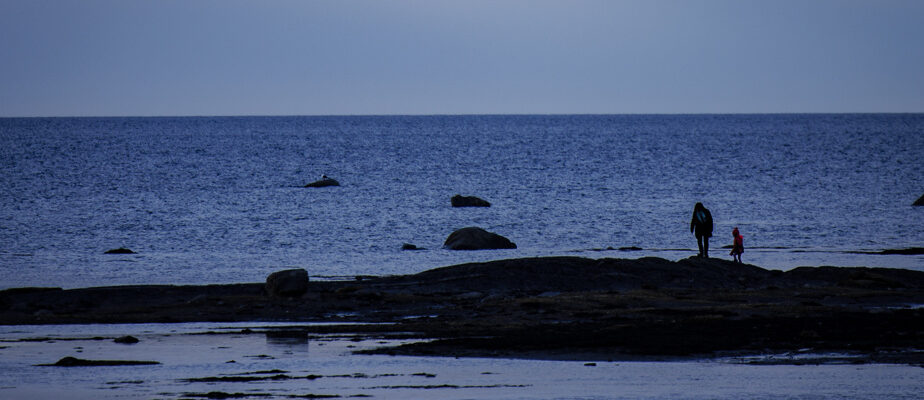Several pressures on the St. Lawrence
Scientists from the Maurice-Lamontagne Institute, located in Mont-Joli, in Bas-Saint-Laurent, presented on Wednesday an assessment of the state of the estuary and the Gulf of Saint-Laurent. Four researchers addressed in turn the issues affecting water warming, oxygenation and acidification, long-term projections as well as the impacts on one of the species present, namely herring.
“Almost all indicators are in the red. We are at almost record temperatures. We have the lowest values for oxygenation and the highest values for acidification almost ever recorded. It is difficult to [tirer un autre bilan] that the St. Lawrence has never been so stressed in terms of pressure on resources,” points out Peter Galbraith, oceanographer at the Maurice-Lamontagne Institute.
Heat records accumulating
As part of the Atlantic zone monitoring program, researchers are notably evaluating the temperatures in the three water layers of the St. Lawrence, namely the surface layer, the cold intermediate layer and the bottom layer.
In the Gulf, a new surface record was recorded in July, 2.5°C higher than the monthly average of the last 30 years. This mark was broken in October, reaching 2.8°C. “But the big story happened in the estuary,” explains Peter Galbraith. At the end of September, beginning of October, we were at 12°C on average, which is as hot as you would expect to see at the end of July, beginning of August. We had records [de hausse] 4.8°C in September and 5°C in October. »

PHOTO EDOUARD PLANTE-FRÉCHETTE, LA PRESSE ARCHIVES
Group of seals off the coast of Tadoussac
Less and less oxygen
While warming waters lead to a decrease in oxygen, an increase in CO emissions2 causes ocean acidification, two phenomena observed by scientists in the St. Lawrence. From the outset, biologist Marjolaine Blais specifies that water considered low in oxygen has a saturation rate of 30%; at 20%, the level can be fatal for certain aquatic species. The most tolerant species, such as halibut and northern shrimp, cannot survive at rates below a range of 10 to 15%. However, since 2022, the deep waters located opposite Rimouski have had an oxygen level of around 10%. “It’s a severe hypoxia threshold,” explains M.me Blais. There are no commercially valuable species that can survive at this level over a long period of time. »
Increasingly acidic waters
The St. Lawrence is also not immune to the acidification of its waters. Researchers notably recorded an increase in the acidity of the water by 60% in 15 years opposite Rimouski. “The estuary and Gulf of St. Lawrence are currently experiencing unprecedented changes in chemical and biological conditions. What is happening with the drop in oxygen and the acidification of the waters are pressures which will be added to the increases in temperature and the organisms [présents dans le Saint-Laurent] will have to face all of this, says Marjolaine Blais. We add a layer with what happens with production cycles, the food chain. These are changes that add a layer of pressure on organizations that must adapt to multiple pressures,” she explains.
Several losers and a few winners
“The surface waters of the northwest Atlantic are among those warming the fastest in the world,” recalls Hugues Benoît, researcher at the Maurice-Lamontagne Institute. However, herring is one of the fish species whose size can be influenced by the effects of warming waters. For populations located to the south of the Gulf, we observed a drop in the size of herring of around 11 to 22%, while in the north, it was limited to 5%, underlines the researcher. “We see that local populations are adapting to the conditions in place,” he adds to explain the differences between the herring populations in the north and the south.

PHOTO ALAIN ROBERGE, LA PRESSE ARCHIVES
Counter of a fishmonger in Kamouraska
“It’s clear that there are significant changes with a trend that is not encouraging, but at the same time, with warming, there are also species that are doing very well,” also notes M. . Benedict. I think there are lobster fishermen on the North Shore who are very happy. If I am a bluefin tuna, I am very happy to return to the gulf, these are very favorable conditions. »
Learn more
-
- 70%
- In 50 years, oxygen concentrations at a depth of 300 meters have decreased by 70% in the St. Lawrence estuary.
Source: Maurice-Lamontagne Institute
- 1969
- The maximum volume of sea ice in the St. Lawrence was 6 km3 in 2024, the lowest level recorded since 1969.
Source: Maurice-Lamontagne Institute
